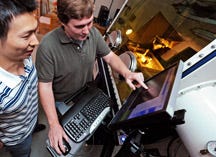Laser Deposition Method May Revolutionize Fabrication of Joint Implants
September 24, 2009

purdue
Members of the laser research team at Purdue University review data using a laser deposition system. The system works by depositing layers of a powdered mixture of metal and ceramic materials, melting the powder with a laser, and then solidifying each layer to form parts.
With the demand for artificial hips in people under the age of 40 expected to reach 40 million annually by 2010 and 80 million by 2030, scientists are hard at work developing methods to expedite their manufacture, reduce their cost, and increase their durability. Take Yung Shin, professor of mechnical engineering and director of the Center for Laser-Based Manufacturing at Purdue University (West Lafayette, IN). "We have 200,000 total hip replacements in the United States," he remarks. "They last about 10 years on average. That means if you receive an implant at 40, you may need to have it replaced three or four times in your lifetime."Shin is pioneering technologies that use lasers to create longer-lasting medical implants and arterial stents. One of his techniques involves depositing layers of a powdered mixture of metal and ceramic materials, melting the powder with a laser, and then immediately solidifying each layer to form parts. Known as "functionally gradient coating," this technique for forming parts one layer at a time is suitable for coating titanium implants with ceramic materials that mimic the characteristics of natural bone, Shin explains."Titanium and other metals do not match either the stiffness or the nature of bones, so you have to coat it with something that does," Shin said. "However, if you deposit ceramic on metal, you don't want there to be an abrupt change of materials because that causes differences in thermal expansion and chemical composition, which results in cracks. One way to correct this is to change the composition gradually so you don't have a sharp boundary."
Researchers have used this laser deposition process to create a porous titanium-based surface and a calcium phosphate outer surface, both designed to better match the stiffness of bone than conventional implants. By creating a strong bond between the material being deposited and the underlying titanium, steel, or chromium, the method can create a bond that is at least seven times as strong as that required by industry standards.
In addition, the process enables the fabrication of parts with complex shapes that are customized for each patient. "These are not like automotive parts," Shin says. "You can't make a million that are all the same." He envisages a time when medical imaging scans will be sent to laboratories where implants will be made using laser deposition. "Instead of taking 30 days like it does now because you have to make a mold first, we could do it in three days. You reduce both the cost and production time."
Additional research is needed before the techniques will be ready for commercialization. Future work will involve studying shape-memory materials that are similar to bone and also have a self-healing capability for longer-lasting implants.
You May Also Like


